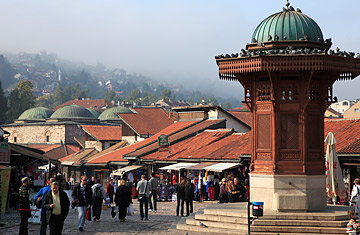
Pigeon Square in Sarajevo, September 24, 2010.
(2 of 2)
Things change, however, upon leaving the central part of the city. In Dobrinja, the Olympic neighborhood made of blocks of buildings separated by large lawns, people just have to look up to the tops of the buildings to see some of the marks left by bullets in the concrete. "It's mostly the facades that have been improved", says the architect Nenad Basic, "The front is rebuilt, but not the inside."
Holes in the concrete are still everywhere, and so are pot-holed pavements. Dobrinja suffered much during the war, the district running along the infamous "Sniper Alley." Nenad came back in April for the first time since the war. He says his neighborhood birthplace has not changed that much, except for the big mosque built by the Saudis. In the countryside, close to Sarajevo, the landscape is yet again different. Everywhere, shattered houses remind people that they once had owners, who are dead or in exile: the ethnic cleansing and the war chased more than one out of two Bosnians from their home. It is impossible to deny that something terrible happened here.
"Sarajevo is like a phoenix. We survived a massacre, you know: 13,600 deaths, including 1,600 children," says Sarajevo's mayor, Alija Behmen. In his office, he has a picture of Juan Antonio Samaranch, the former International Olympic Committee (ICO) president, who brought the summer Games to the city in 1984. A clip-framed copy of a Jewish sacred book, the Haggadah, lies next to it. It was saved twice, first from the Nazis and then from the Serbian attacks. According to this former minister, the city is doing better now. Of course there are numbers of bank accounts on all the city's website pages that call for donations: "We always need money. But the situation has improved. The city center is restored ; the schools, the hospitals and the factories function again."
The only giant exception is the National Library, which lost 80% of its books in a huge fire lit by Serbian soldiers. Despite financial help from the European Union, scaffolds barely hide the still blackened walls. Projects are developing but nothing has been scheduled. How does Alija Behmen explain this? "Corruption is every society's cancer," he sighs.
As always, the architectural issue is as problematic as the political one. To talk about churches and mosques is to question this once one-of-a-kind cohabitation among Catholics, Muslims and Orthodox, or what's left of it. People living in Sarajevo all agree that their city has changed. The reconstruction of the city's buildings does not conceal the changes among the population. Many intellectuals left, during and after the war, weakening the social diversity. Old families had to leave their apartments to the profit of displaced people supported by paramilitaries.
Thus, the sociological diversity of the city kept changing, provoking deep upheaval. One meaningful example is the Oslobodenje tower which hosted the widely admired independent daily newspaper that continued to come out, come what may, during the war. It was destroyed to make room for the spectacular Avaz Twist Tower, which now hosts a tabloid. The highly modern building towers above the city.
An obsessive question remains: was it necessary to rebuild everything as it was? Wouldn't it be better to change everything and to enter once and for all into the 21st century? Some say that would be crazy. Certain buildings represent so much of the city's heritage that their disappearance would affect its identity. The pieces of modern architecture that can be found in Sarajevo are rarely beautiful: big glass cube buildings hosting banks and foreign companies and running untidily along the former "Sniper Alley."
Jean-François Doualas, who has never been back since leaving in 1994 for France says: "Sarajevo was built by Ottoman merchants, around their caravanserai. It is not surprising that everything that is built today revolves around trading." Thus, according to this Paris-based architect: "The problem in Sarajevo is not architecture, but city planning. The different spaces are not interconnected." But perhaps the biggest question is the lack of real interaction between the "Serbian districts" and the "Bosnian districts". The streetcar line that serves the city center stops before the Serbian districts. Bosnians from Dobrinja do not go to the hospital located in the Serbian part of the neighborhood. And so even though 80% of the listed monuments have been officially saved, the most important one — that of a peaceful cohabitation between peoples — is still to be rebuilt.
Also from Worldcrunch:
A One-Time Nazi Resort Now a Youth Hostel.
— Die Welt
Trash Emergency Encircles Beijing.
— Economic Observer
The Egyptian Revolution, Class Conflict and 'Thuggery'.
— Al Masyral Youm
